Dionysius Periegetes
Orbis terrae descriptio
|
The dating of the author of the Greek poem called in Latin De situ habitabilis orbis Dionysius Periegetes (the Guide) life varies from 405 BC to 124 AD. So, the timing of the evidence has an upper, the most conservative limit, 124 AD. Among topics that were subject of voluminous and tortured
speculations aimed at re-writing history under a pretence of new discoveries are: With this evidence of the contemporary, no wonder that fabrications are largely limited to the propaganda department, with sound bites substituting for scholarship. For more Turkofilic gems of Classical time, see Maps of Antique World, Dionysius was not the only ancient writer to blunder into the modern patriotic IE minefield. |
|
Links |
|
http://www.henry-davis.com/MAPS/Ancient Web Pages/117.html |

fl. c.300? B.C., Greek poet. He wrote the poem Description of the Inhabited Earth, which was popular in antiquity.
Dionysius of Alexandria, called Periegetes (the Guide), was a contemporary of the great Hellenistic geographers Marinus of Tyre (ca. 70 - 130 AD) and Claudius Ptolemy (ca 90 – ca 168AD). He composed a description in verse of the inhabited world (AD 124) that was long used as a school textbook.
Dionysius, a Greek author of the time of Hadrian (76–138AD), is commonly known as Periegetes (the Guide), to distinguish him from other authors of the same name and refers to his work Orbis terrae descriptio, called De situ habitabilis orbis ("Descriptive Account of the Habitable World"). Designed more as a geographical handbook for a reader of the Greek poets than as a systematic or scientific treatise on geography, De situ habitabilis orbis undertakes a verse account of the known world and its seas, countries, and islands.


The 1543 Aldine edition of De situ habitabilis orbis was translated into Latin verse by Simon Lemnius, who in his dedicatory preface mentions both Amerigo Vespucci and Columbus and the discovery of America. The title page of this work has a view of the earth which shows South America, labeled "America." Franciscus, mentioned in the colophon, is Francesco Torresani, the uncle of Paulus Manutius.